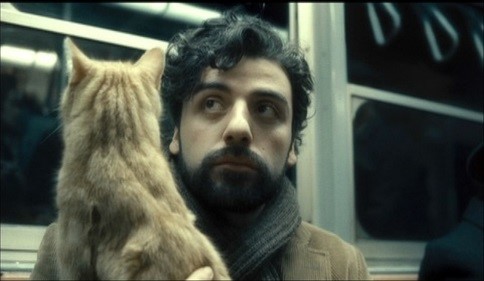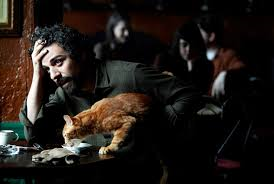

Inside Llewyn Davis, is a Coen Brothers mock biopic depicting a struggling singer in 1960s New York. The film leads the central character Llewyn to question whether or not he should continue to perform music following the suicide of his singing partner, Mike.
The theme of alienation reoccurs throughout the film and is reinforced by the presence of the cat. The cat also represents Llewyn’s disillusionment in his music career. Pet cats are stereotypically independent animals, which the Coen brothers choose to subvert to show how deprived of human companionship Llewyn has become following the death of Mike. The cat at first seems intrigued and reliant on Llewyn, but eventually escapes him, the same as the human companions he has during the film abandon him. At the start of the film Llewyn is alone in an empty apartment and is awoken by the cat as it jumps on him. Coen uses a shot reverse-shot of Llewyn and the cat, with Llewyn framed from above and the cat from below, which emphasises Llewyn as subordinate to the cat. This subordination continues as he follows the cat out of the bedroom. The framing of the shot in which Llewyn follows the cat down the hallway seems very claustrophobic and narrow, trapping and isolating Llewyn. This implies that he feels helpless and not in control. This lack of control of his own future shows the lack of control Llewyn has begun to feel he possesses over his music career, and his life more generally due to his homelessness and dependence on other humans, similarly to pet cats. This scene shows him as having more in common with a stray animal than other humans. The lighting of the shot is also very dark and shadowy, adding to Llewyn’s sense of disorientation. The cat is lost by Llewyn due to him recklessly leaves the window open at Jim’s apartment. This abandonment of Llewyn by the cat perfectly mirrors his relationships with women and family in the film. Therefore, the Coen’s show that the lost cat not only stands for a music career that becomes out of reach due to new developments in music, but also a lack of much needed companionship during his time of need.
Llewyn obtains autonomy from the cat when he leaves it stranded after running it over. After clipping the cat with the car Llewyn leaves it for dead, symbolically also letting his music career and chances of parenthood die as well. We can only see the outline of the cat but it is discernibly injured. The scene is dark yet the snow has a slight red illumination to it representing the death, or at least injury of the cat. At this point Llewyn thinks he has moved on from his past and can start again, taking a brief moment of inward reflection and consideration before abandoning it. The Coen’s represent the death of the cat in this way to portray their protagonist as an anti-hero, a character that the audience shouldn’t want to sympathise with due to this cruelty to an animal. He still remains isolated as his travel companion doesn’t even awaken from his sleep, showing death as something happens without people noticing or caring. Overall, the film shows alienation as something that follows Llewyn, even after the existential emblem of his alienation is killed, he still cannot escape it. His life has become an ever repeating cycle as exemplified by the final scene being a repeat of the first, even though the depiction of New York shows a place that is moving forward without him.
